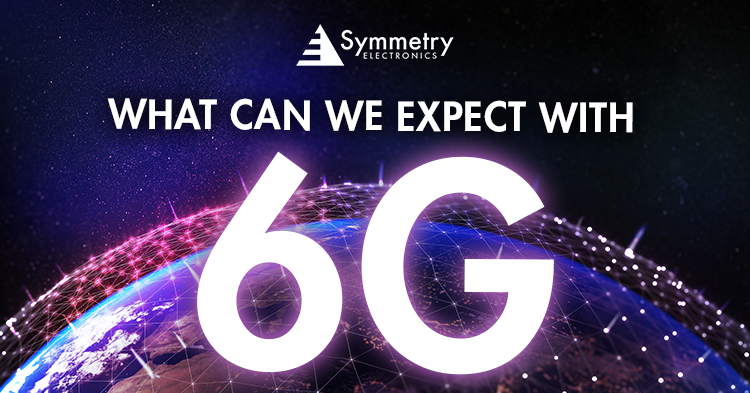- Home
- Symmetry Blog
- What Can We Expect With 6G?
What Can We Expect With 6G?
About Jari Haiston

What is 6G?
The sixth generation (6G) of wireless communications technologies is the upcoming standard of cellular data network infrastructure. 6G cellular network standards are still in development but, in comparison with 5G, expectations surrounding 6G indicate the generation’s superiority in speed, detail, and innovation.
Does 6G Exist?
With its predecessor only just beginning its establishment as a cellular network standard, it’s hard to imagine that 6G will hit the market anytime soon. While 5G standards are forecasted to continue rolling out through the next decade, plans for 6G development are already in motion. 6G plans to launch in 2030 and be fully operational by 2032. 6G test satellites were launched in 2021. The Federal Communications Division (FCC) has opened spectrum frequencies over 95 GHz to 3THz for 6G testing to commence. The truth is, 6G cellular network standards are just upon the not-so-distant horizon.
Key Features of 6G Technology:
- 6G plans to support data rates at 1 TB per second by using multiple access points.
- One of the primary goals of 6G is to reduce latency to 1 millisecond.
- By utilizing Terahertz signal transmission to measure absorption and adjustments, 6G technology will support and expand 5G cellular network standard capacity.
- 6G plans to integrate AI-powered core networking and network management through edge computing.
- 6G will provide significant improvement to imaging and localization technologies.
- These advancements will have an impact on many governmental and industrial applications with advancements in:
- Threat detection
- Decision-making technology for areas like law enforcement and social credit systems
- Air-Quality Sensing
- Health monitoring
- Emergency and disaster response
- Mobile technology
- Virtual/Augmented Reality
- Smart Cities
- Autonomous Vehicles
- These advancements will have an impact on many governmental and industrial applications with advancements in:
Future Scope of 6G Fully Integrates Innovation in Our Lives
One of the most exciting things about 6G technology is the new business opportunities it will provide. Taking into consideration the unforeseen business developments that came about because of 4G LTE network standards (Doordash, Uber, Venmo, etc.), the possibilities with 6G are limitless. Ron Nersesian, Chairman and CEO of Keysight Technologies, stated in an August 2021 Forbes article that “From the consumer perspective, 6G will make mobile communications an even more fundamental part of our daily lives, including driving to work, educating our children, seeking healthcare, shopping, banking, and more.”
6G Cybersecurity and Privacy
Any integration of new technology strives to improve on vulnerabilities in the previous generation and anticipate challenges that may arise in the next. 6G’s web of IoT use cases makes it susceptible to software-based cyber threats. Developers are working to mitigate attacks through establishing and reinforcing network security standards.
In Finland, the 6G Flagship Project, published a white paper on Research Challenges for Trust, Security and Privacy. In it, they called for “physical layer security techniques” as solutions to software hostility in 6G networking. The white paper also addresses privacy issues of future networking, “There [are] currently no means to unambiguously determine when linked, deidentified datasets cross the threshold of becoming personally identifiable.” The 6G Flagship Project offers “blockchain, distributed ledger technologies and differential privacy approaches” as suggested strategies for a safer 6G experience.
In summary, it’s not too early to begin thinking about the future that 6G technology holds. Consortiums, research institutes, and nations are investing resources to develop a method of standardization around 6G networking. 6G technology creates substantially more data than 5G networking because of its advanced imaging, sensing, and localization capabilities. Data centers need to be ready for the new platform as they will oversee managing mined data for individuals, network owners, and service providers. Ultimately, the way we integrate 5G as our next network standard will be the stepping stone to successfully incorporate 6G technology when the time comes.
